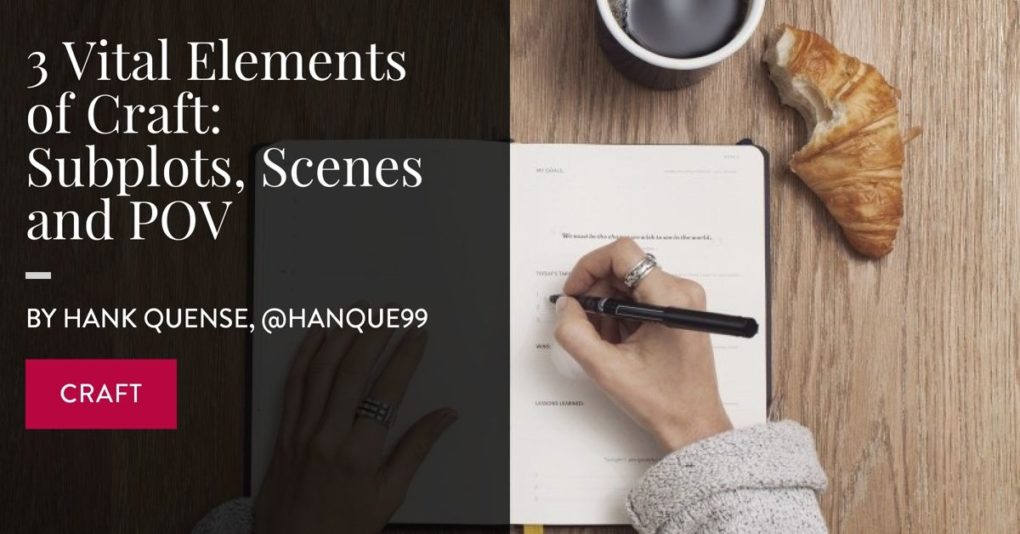by Hank Quense, @hanque99
Today, author Hank Quense offers tips on three vital elements of the writing craft: subplots, scenes, and POV.
Integrating subplots naturally:
I’ve seen subplots mishandled many times. When this happens, the subplots interfere with the main plot.
The trick is how you approach subplots. They are by their nature “subordinate.” Subplots have a defined space within the novel; they can’t just be thrown into the story any which way the author feels like it. If you have more than one subplot you have to categorize them from most important to least important. The subplots are then nested within the main story line. Like this: after the characters are introduced and the plot problem recognized, a scene from Subplot A can be added. After a number of scenes from the main plot and an occasional one from Subplot A, Subplot B is introduced. More Main plot scenes are broken up by scenes from Subplots A and B. Then Subplot C is begun. Now the bulk of the story continues with the subplot scenes dropped in to break up the Main plot.
When the story approaches the climax, Subplot C is finished first. The Main plot continues and Subplot B is closed out. The Main plot moves closer to the climax and Subplot A is finished up. Now the way is clear for the reader (and the author) to concentrate on the story’s climax.
It is not good form to have a subplot continue beyond the climactic scene from the main storyline. Once the climax of the main plot is reached and the validation scene shown, the story is over. The reader will no longer be interested in the outcome of a subplot. This means the validation scene is the end of the story. Don’t keep adding scenes from subplots.
Another caveat is this: If the story starts out with a scene or two from a subplot, the reader will get confused and assume the subplot is the main plot.
The most important elements of scene design:
Every scene should have four elements in it: setting, sensory information, a goal and an emotional arc.
The setting may not be needed if the scene occurs in a place that has already been described. If the place is new to the reader than the setting should be described. This is often done in the opening sentence or two using omniscient point-of-view.
Sensory information such as taste, smell or feel is optional, but include the roar of traffic or the smell of wood smoke can add details to the scene.
A scene goal is mandatory unless the scene characterizes a character. The goal of the scene is to move the reader and the story closer to the story’s climax. This goal doesn’t have to be reached in the scene. It may take a number of scenes to reach the goal but each scene must advance the story closer to the scene goal and the story’s climax. If the scene doesn’t characterize someone or have a goal, then it’s just excess words and should be deleted or revised.
An emotional arc is mandatory in all scenes. The main character in the scene has a starting emotional point. By the end of the scene, that emotion must change. It can be more positive or more negative, but it must change. A scene with no emotional change isn’t a satisfactory read.
Why must their be an emotional arc? To jerk the reader around. Readers love to see emotional highs and lows and they appreciate being jerked around. It’s what separates okay stories from great stories.
Choosing the POV for your story:
This is a personal decision every author has to make with each story. I prefer third person limited. I have written a few stories in first person, but it doesn’t feel natural to me. Of course, omniscient point-of-view is the easiest one to use because you can’t make a POV violation like you can with third person limited or first person. Omniscient is an obsolete way of writing an entire story, so a writer’s choice really comes down to third or first person. I think the choice depends upon which one the writer is more comfortable with. Fortunately, there are no wrong choices here.
How do you integrate subplots into your story or choose POV? Have you checked your scenes to see if they have 4 major elements in them?
Author @hanque99 on 3 vital elements of craft (via @MCBookTours ): Share on X Creating Stories concentrates on developing characters including such rarely discussed requirements such as a dominant reader emotion and the character’s biography.
Creating Stories concentrates on developing characters including such rarely discussed requirements such as a dominant reader emotion and the character’s biography.
Plots are also covered in depth and a number of graphics are included to illustrate complex points. Another topic discusses subplots and how to utilize them and how to nest them within the main plot.
A separate chapter discusses the relationship between the plot and the emotional arcs.
Other topics covered are character arcs, scene design, point-of-view, writing voice.
About the Author:
 Hank Quense writes humorous and satiric sci-fi and fantasy stories.
Hank Quense writes humorous and satiric sci-fi and fantasy stories.
He also writes and lectures about fiction writing and self-publishing. He has published 19 books and 50 short stories along with dozens of articles. He often lectures on fiction writing and publishing and has a series of guides covering the basics on each subject. He is currently working on a third Moxie novel that takes place in the Camelot era.
He and his wife, Pat, usually vacation in another galaxy or parallel universe. They also time travel occasionally when Hank is searching for new story ideas.
You can connect with Hank on his Amazon Author Page.
You can check out the schedule and follow Hank’s tour by clicking HERE.
GIVEAWAY DETAILS:
This tour-wide giveaway is for five (5) eBooks of CREATING STORIES and three (3) print copies of the author’s MOXIE’S PROBLEM (U.S. entries only). The prizes are courtesy of the publisher. The giveaway will end at 12 a.m. (EST) on Tuesday, April 18.
To enter, click on the Rafflecopter widget below and follow the instructions.
a Rafflecopter giveaway
Photo via Visual hunt

Really useful advice for me as a newbie writer working on a first attempt at a novel. It is realistic speculative fiction, and I am at a little over 25k words of first draft so far. Thanks!
I’m glad my advice was able to help you, Gerard.
I have read stories where the subplot does seem to overtake the main plot and it makes you wonder why that wasn’t the theme to begin with. Elizabeth, thanks for being a part of Hank’s tour.
Mason
MC Book Tours
Happy to do it…great post. :)
If I end up with a subplot in my stories, it’s completely by accident.
Point of view will always be third. I find first person just too unnatural to write.
Alex, I’ve written one or two short stories in first person POV and it just doesn’t feel natural. I always use 3rd also
This is a really interesting and helpful post. It can be so tricky to weave in sub-plots; and, yet, they can add much to a story. And the right POV is vital. Otherwise, readers aren’t drawn in. And as for scenes, they’re what hold a story together and keep the reader turning and swiping pages. So they are critical to consider when one’s writing or revising. Thanks for the advice, both.
Thanks Margo. I spend a lot of time on scene design.
I’ve deleted a lot of scenes that didn’t move a story forward. One book lost over 30,000 words that way.
It takes a bit of courage to delete a lot of scenes. Alas, scene design isn’t something you see in books on fiction writing.
Wow. Never thought of having a sensory component for each scene. I’m not a visual person, but thinking of it this way might be a really big help to me. Thanks!!
You’re welcome, Jamie.
I think the advice to resolve subplots before the resolution of the main plot is good in general, but I have to point out that there are many well received books that do not follow this rule. Consider The Maltese Falcon. Spade’s partner is killed. The event seems to be part of the build to the main event: the chase for the bird. We think that the partner’s murder is resolved with the resolution of the bird (the revelation that it is a fake), but no! We find that the partner’s death was always the main event for Spade and the partner murder subplot holds the final resolution.
So what does this mean? Your advice is good, and certainly applies to a potzer like me, but I think masters like Hammett may not always follow it.
The better you get at writing and the bigger your resume, the more you can “cheat”. Others have to stick with the rules.
Hank,
I really needed this checklist to help me through each scene. Thanks!
You’re welcome, Sharon. Scene design doesn’t get the recognition it deserves.
Great advice, Elizabeth. Thank you so much for sharing. Wishing you a lovely week.
You too, Nicola! Hank did a great job with a helpful post.
More accurately, Elizabeth, you did a great job in picking the questions. Yours were so refreshing. Too many times, I get nonsense questions like “How long have you been writing?” or “Where were you born?”
I get those types of questions a lot, too! :) And thanks.
It’s exciting to see such great exposure on Hank’s book. He’s a talented man and a true icon. Thanks for this feature, Elizabeth.
Glad to do it! And he wrote a great post. :)
Thank you Joylene and Elizabeth